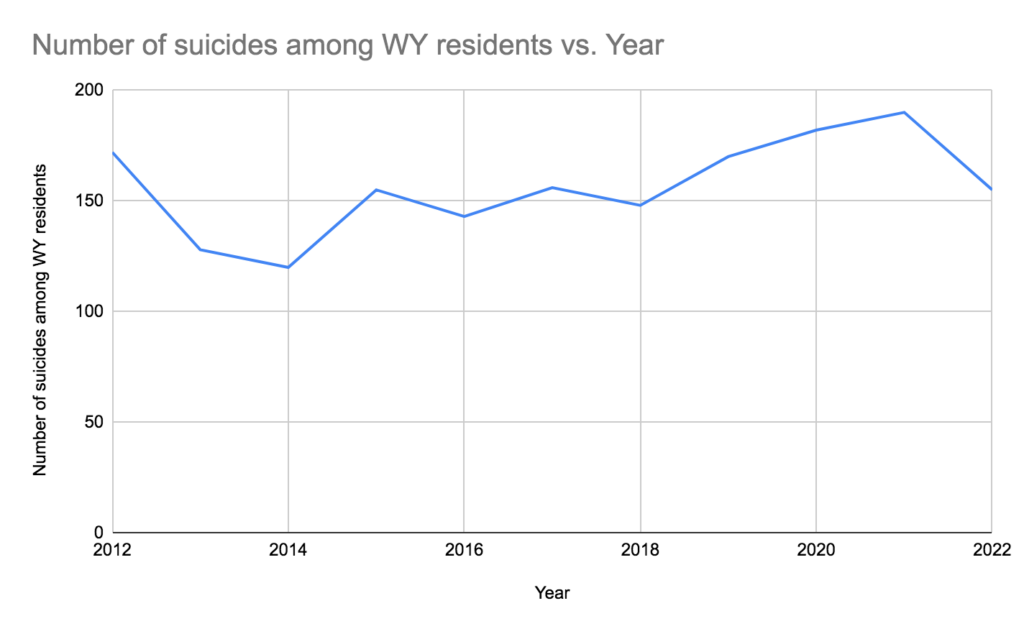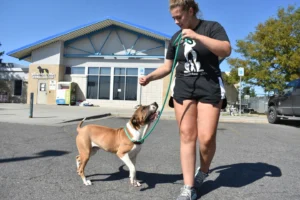Wyoming’s Suicide Rate Declines 18%, New Data Shows
Drop follows expanded suicide prevention services
- Published In: Other News & Features
- Last Updated: Nov 07, 2023

By Shen Wu Tan
Special to the Wyoming Truth
Suicides in Wyoming dropped by 18% in 2022 – a positive shift for a state known to consistently rank in the top five nationally for its high suicide rate – newly published data reveals.
The state’s health department recorded 155 suicides last year, down from the 190 documented in 2021, according to a report released Oct. 24. Records reveal that 136 men and 19 women took their lives in 2022—most of them (104) by firearms. Twenty-eight individuals died from hanging, 15 from poisoning and eight from other means.
Although the suicide rate for Wyoming fluctuates, it had steadily increased since 2018 when the state recorded 148 suicides. In 2021, Wyoming saw about 33 suicides per 100,000 individuals—the most reported since 2004 when the state health department began publishing data. The suicide rate for Wyoming also was more than double the nationwide rate of 13.5 suicides per 100,000 people.
“We believe it is too soon to tell if a decline in Wyoming resident suicides in 2022 as compared to 2021 will continue,” said Kim Deti, spokesperson for the Wyoming Department of Health. “Given our state’s small population numbers, these totals fluctuate significantly from year to year…. While we certainly hope early indications that our suicide rate may be flattening instead of continuing the linear increase over time we had been seeing, it really is too soon to tell if that will be the case.”
Possible explanations for Wyoming’s historically high suicide rate could be social isolation, financial struggles, high firearm ownership rate per capita and the cultural stigma around seeking help with mental health issues, she previously noted.
Dan Hedrick, a former grief support coordinator at Grace for 2 Brothers Foundation, a now disbanded suicide prevention nonprofit, said he is “cautiously optimistic” about the recent decline in suicides.
“You’d like to think that you’re headed in the right direction, but you never really know because sometimes everything can cycle back,” Hedrick, who lost his younger brother to suicide in 2011, said about the decrease in suicides and the fluctuating suicide rates. “I think a lot of what helped drive those numbers down was the implementation of 988. I honestly believe that it was great that people who were in crisis and called actually had somebody to talk to [who] was in their neck of the woods.”
Suicide prevention services ramp up
Earlier this year, the state legislature took steps to expand suicide prevention services. In February, Gov. Mark Gordon signed a law that created a trust fund for 988, the nationwide mental health crisis hotline, to help back call centers and other services 24/7. The two local call centers, Wyoming LifeLine in Greybull and the Central Wyoming Counseling Center in Casper, each receive roughly $100,000 in state general funds and $399,357 in American Rescue Plan Act federal funding annually for base-level operations, according to Deti.
The 988-system trust fund includes money assigned to the account by law and money collected from federal grants, gifts, donations and other contributions. During each fiscal year starting July 1, 2024, the trust fund’s earnings will be appropriated to the state health department, allowing it to spend 5% of the previous five-year average market value of the account.
Wyoming obtained around-the-clock in-state coverage of suicide calls thanks to federal funding when 988 launched in July 2022. Both Wyoming LifeLine and the Central Wyoming Counseling Center received federal money to expand their hotlines to 24/7 coverage. Wyoming LifeLine now answers calls from 2 a.m. to 4 p.m., while the Central Wyoming Counseling Center takes calls from 4 p.m. to 2 a.m.
Calls have climbed since 988 launched, Deti added. The focus on suicide prevention in Wyoming and nationwide, as well as the promotion of the hotline, have potentially encouraged people to use the resource, which is “certainly a positive development,” she said.
Wyoming was the only state in the U.S. without a suicide lifeline call center until the state legislature appropriated funds for one in 2020. Out-of-state suicide call centers previously fielded all calls from Wyoming.
“I would like to say we’re making a dent now, but I’d be a fool to take that to Vegas and put it on a table and say, ‘Hey, this is it,’” Hedrick said about the dip in suicides. “It’s kind of hard for people who do any type of intervention work or suicide prevention work, because you never really know if you succeeded. There’s no real way to quantify it.”













